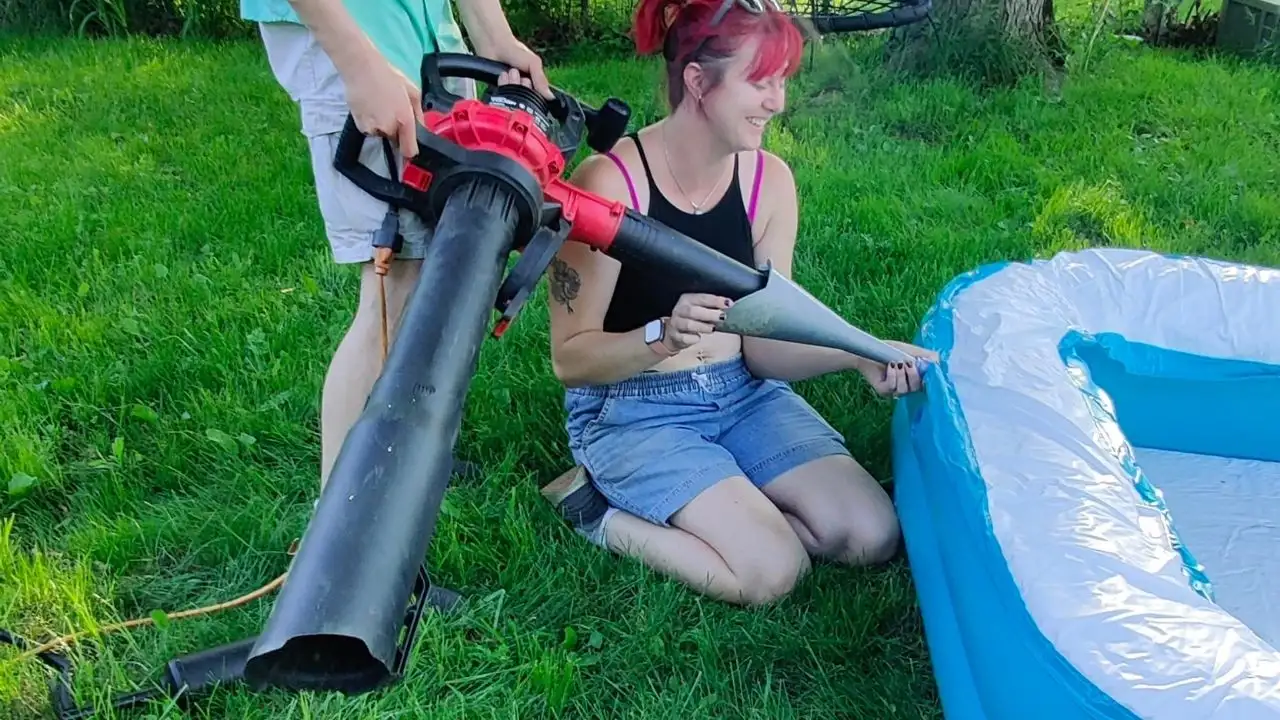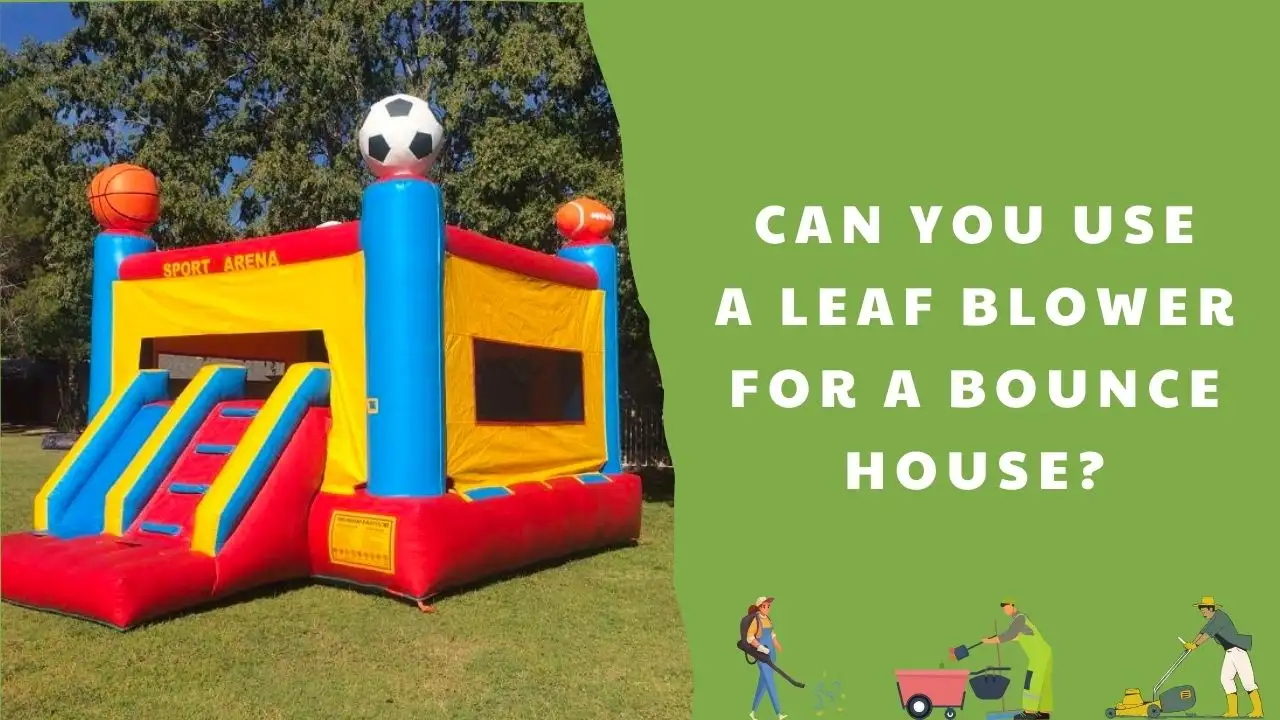So can a leaf blower be used for a bounce house? Let’s find out with Garden Nurturer and discover whether the leaf blower is really the unsung hero of the bustling castle.
Can you use a leaf blower for a bounce house?
Yes, you can use a leaf blower to inflate a bounce house, but there are a few important considerations to keep in mind:

- Power and Efficiency: A leaf blower may not be as efficient as a dedicated air blower for bounce houses. Bounce house blowers are specifically designed to provide a steady, strong airflow required to keep the structure inflated. Leaf blowers, on the other hand, are designed for short bursts of air and may not sustain the consistent airflow needed.
- Nozzle Fit: The nozzle of the leaf blower needs to fit securely into the bounce house’s air intake. If it doesn’t fit properly, you won’t be able to inflate the bounce house effectively, and air could leak out.
- Air Pressure: Leaf blowers may not provide the right air pressure for a bounce house. Too much pressure can damage the bounce house, while too little pressure won’t keep it properly inflated.
- Safety Considerations: It’s important to monitor the bounce house while using a leaf blower. Since they are not designed for continuous operation like bounce house blowers, there’s a risk of overheating or other mechanical issues.
- Noise Level: Leaf blowers tend to be noisier than bounce house blowers, which could be a consideration in a residential area or a setting where noise is a concern.
Instructions on how to use a leaf blower for a bounce house
A leaf blower, with its high-speed airstream, might seem like a plausible substitute for a bouncer’s blower at first glance. In some cases, it can indeed serve as a temporary power source, but safety and stability are paramount to consider.

Steps to Safely Use a Leaf Blower with a Bounce House
If you find yourself with no other option than to use a leaf blower to inflate a bounce house, here are some steps to do so to maximize safety:
Step 1: Ensure the leaf blower is appropriate for the size of the bounce house. The blower must provide enough air volume to keep the house fully inflated without overexerting the motor.
Step 2: Check the bounce house’s power rating and ensure the leaf blower’s motor surpasses this rating to prevent under-inflation, which can lead to structural instability and an increased risk of accidents.
Step 3: Use a ground fault circuit interrupter (GFCI) protected outlet to prevent electric mishaps.
Step 4: Secure the leaf blower to the bounce house to maintain an airtight connection. Using heavy-duty tape or a suitable connector can help prevent air leaks and keep the house steady.
Step 5: Monitor the inflation process closely, ensuring the bounce house inflates evenly and reaches its full capacity without straining the leaf blower.
Precautions and Safety Guidelines
While it is possible to use a leaf blower for a bounce house, it is not without its risks. Here are some important precautions to take into account:
- Never leave a leaf blower unattended while it is powering a bounce house.
- Be mindful of the blower’s power and the potential for it to cause over-inflation or to burst a smaller bounce house.
- Always supervise children around the bounce house, especially during the setup and takedown phases when the blower might be operational.
- Keep the leaf blower clear of water and ensure it is not used in wet conditions. Moisture can cause electric shocks and damage the blower’s electrical components.
- Follow all manufacturer guidelines and warnings for safe usage of the leaf blower.
Advantages of Using a Leaf Blower
When comparing leaf blowers to traditional bounce house pumps, several advantages come to light:

Cost-Effectiveness
If you already have a leaf blower at home, using it for your bounce house can save on the expense of purchasing or renting a specialized bounce house blower, which can be quite costly.
Efficiency and Convenience
A leaf blower, particularly one with high CFM (cubic feet per minute), can significantly speed up the inflation process compared to using a manual pump or waiting for a smaller fan-style blower to do the job. It can also be more convenient for homeowners who don’t frequently set up bounce houses and prefer a multi-purpose tool.
Things to consider when purchasing a new leaf blower to de-inflate your child’s bounce house
When purchasing a new leaf blower to de-inflate your child’s bounce house, there are several important factors to consider:
- Power and Airflow: Look for a leaf blower with sufficient power and airflow to quickly and effectively deflate the bounce house without causing any damage.
- Portability: Consider the portability of the leaf blower, especially if you need to transport it to different locations for use.
- Noise Level: If you plan to use the leaf blower in residential areas, consider the noise level and opt for a model that is quieter to minimize disruptions.
- Durability: Choose a leaf blower that is durable and can withstand frequent use without experiencing performance issues.
- Safety Features: Check for safety features such as overheat protection and secure housing to ensure safe operation, especially around children.
- Compatibility: Ensure that the leaf blower is compatible with the material and size of your child’s bounce house to facilitate efficient deflation.
- Storage: Consider the size and storage options for the leaf blower when not in use to ensure it can be conveniently stored.
- Price and Warranty: Compare prices and look for warranties to ensure you get good value for your investment and have recourse in case of malfunctions.
Conclusion
In short, a leaf blower can really be an effective tool for inflating and maintaining bounce houses, especially for smaller models or one-time events.
It is important to review leaf blower specifications and safety guidelines to ensure a successful and safe bouncing experience for everyone. Garden Nurturer hopes this article has brought more knowledge to everyone.






